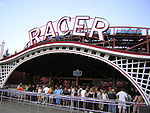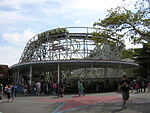Turtle Creek (Monongahela River tributary)
AC with 0 elementsAllegheny PlateauGeographic coordinate listsLists of coordinatesRivers of Allegheny County, Pennsylvania ... and 3 more
Rivers of PennsylvaniaRivers of Westmoreland County, PennsylvaniaTributaries of the Monongahela River

Turtle Creek is a 21.1-mile-long (34.0 km) tributary of the Monongahela River in Allegheny and Westmoreland counties in the U.S. state of Pennsylvania. At its juncture with the Monongahela is Braddock, Pennsylvania, where the Battle of the Monongahela ("Braddock's Defeat") was fought in 1755. In the mid-19th century, the Pennsylvania Railroad laid tracks along the stream as part of its Main Line from Philadelphia to Pittsburgh.
Excerpt from the Wikipedia article Turtle Creek (Monongahela River tributary) (License: CC BY-SA 3.0, Authors, Images).Turtle Creek (Monongahela River tributary)
Great Allegheny Passage,
Geographical coordinates (GPS) Address Nearby Places Show on map
Geographical coordinates (GPS)
| Latitude | Longitude |
|---|---|
| N 40.3897913 ° | E -79.8519929 ° |
Address
Union Railroad Port Perry Bridge
Great Allegheny Passage
15104
Pennsylvania, United States
Open on Google Maps











